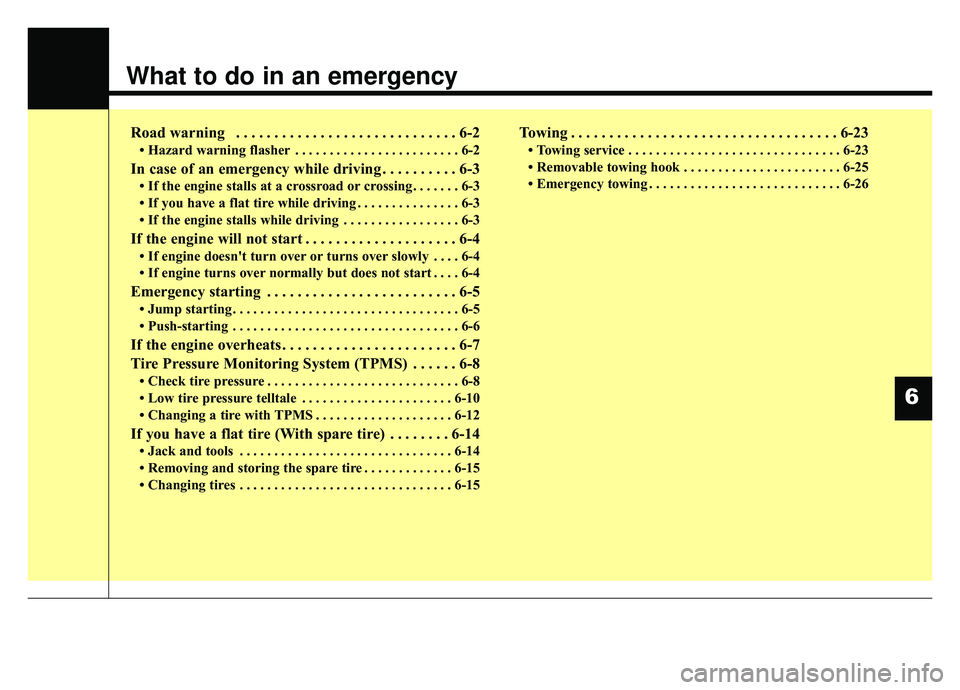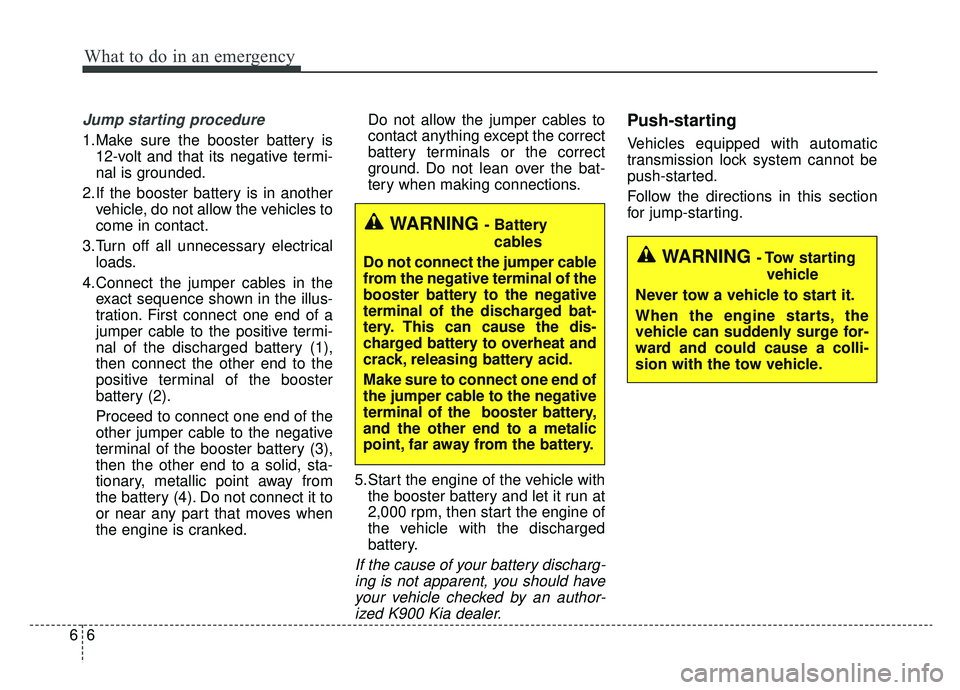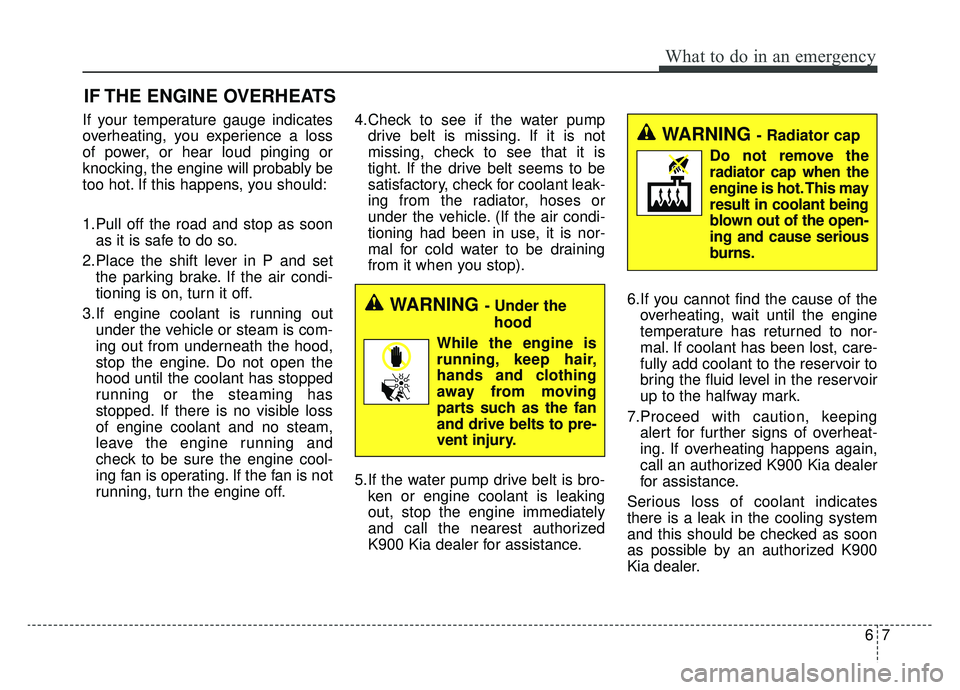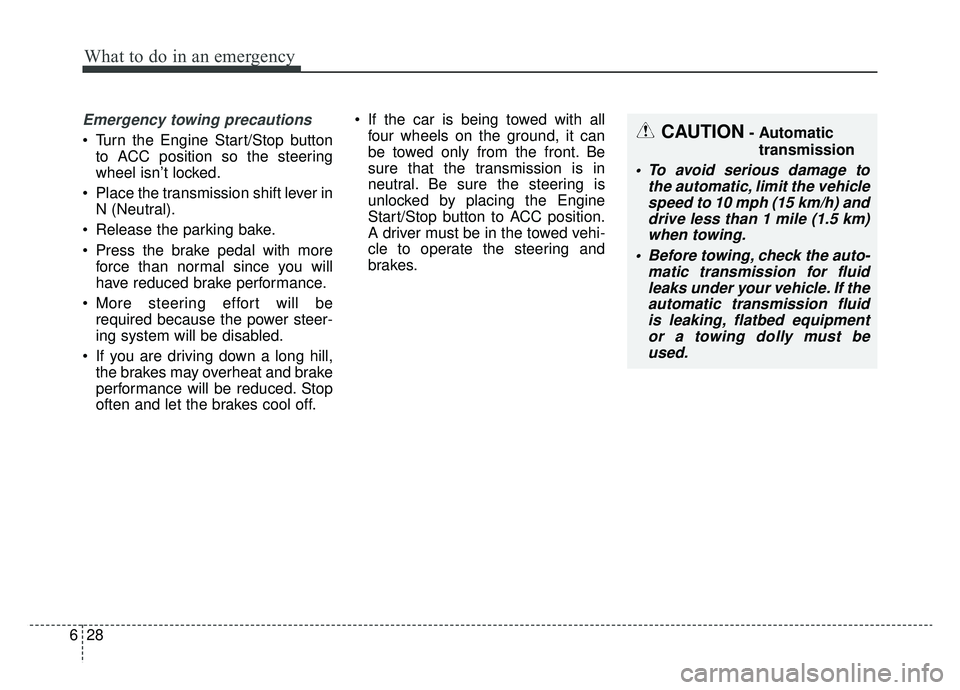2019 KIA K900 engine overheat
[x] Cancel search: engine overheatPage 427 of 580

What to do in an emergency
Road warning . . . . . . . . . . . . . . . . . . . . . . . . . . . . . 6-2
• Hazard warning flasher . . . . . . . . . . . . . . . . . . . . . . . . 6-2
In case of an emergency while driving . . . . . . . . . . 6-3
• If the engine stalls at a crossroad or crossing. . . . . . . 6-3
• If you have a flat tire while driving . . . . . . . . . . . . . . . 6-3
• If the engine stalls while driving . . . . . . . . . . . . . . . . . 6-3
If the engine will not start . . . . . . . . . . . . . . . . . . . . 6-4
• If engine doesn't turn over or turns over slowly . . . . 6-4
• If engine turns over normally but does not start . . . . 6-4
Emergency starting . . . . . . . . . . . . . . . . . . . . . . . . . 6-5
• Jump starting . . . . . . . . . . . . . . . . . . . . . . . . . . . . . . . . . 6-5
• Push-starting . . . . . . . . . . . . . . . . . . . . . . . . . . . . . . . . . 6-6
If the engine overheats . . . . . . . . . . . . . . . . . . . . . . . 6-7
Tire Pressure Monitoring System (TPMS) . . . . . . 6-8
• Check tire pressure . . . . . . . . . . . . . . . . . . . . . . . . . . . . 6-8
• Low tire pressure telltale . . . . . . . . . . . . . . . . . . . . . . 6-10
• Changing a tire with TPMS . . . . . . . . . . . . . . . . . . . . 6-12
If you have a flat tire (With spare tire) . . . . . . . . 6-14
• Jack and tools . . . . . . . . . . . . . . . . . . . . . . . . . . . . . . . 6-14
• Removing and storing the spare tire . . . . . . . . . . . . . 6-15
• Changing tires . . . . . . . . . . . . . . . . . . . . . . . . . . . . . . . 6-15
Towing . . . . . . . . . . . . . . . . . . . . . . . . . . . . . . . . . . . 6-\
23
• Towing service . . . . . . . . . . . . . . . . . . . . . . . . . . . . . . . 6-23
• Removable towing hook . . . . . . . . . . . . . . . . . . . . . . . 6-25
• Emergency towing . . . . . . . . . . . . . . . . . . . . . . . . . . . . 6-26
6
Page 432 of 580

What to do in an emergency
66
Jump starting procedure
1.Make sure the booster battery is12-volt and that its negative termi-
nal is grounded.
2.If the booster battery is in another vehicle, do not allow the vehicles to
come in contact.
3.Turn off all unnecessary electrical loads.
4.Connect the jumper cables in the exact sequence shown in the illus-
tration. First connect one end of a
jumper cable to the positive termi-
nal of the discharged battery (1),
then connect the other end to the
positive terminal of the booster
battery (2).
Proceed to connect one end of the
other jumper cable to the negative
terminal of the booster battery (3),
then the other end to a solid, sta-
tionary, metallic point away from
the battery (4). Do not connect it to
or near any part that moves when
the engine is cranked. Do not allow the jumper cables to
contact anything except the correct
battery terminals or the correct
ground. Do not lean over the bat-
tery when making connections.
5.Start the engine of the vehicle with the booster battery and let it run at
2,000 rpm, then start the engine of
the vehicle with the discharged
battery.
If the cause of your battery discharg-ing is not apparent, you should haveyour vehicle checked by an author-ized K900 Kia dealer.
Push-starting
Vehicles equipped with automatic
transmission lock system cannot be
push-started.
Follow the directions in this section
for jump-starting.
WARNING - Tow starting
vehicle
Never tow a vehicle to start it.
When the engine starts, the
vehicle can suddenly surge for-
ward and could cause a colli-
sion with the tow vehicle.
WARNING - Battery cables
Do not connect the jumper cable
from the negative terminal of the
booster battery to the negative
terminal of the discharged bat-
tery. This can cause the dis-
charged battery to overheat and
crack, releasing battery acid.
Make sure to connect one end of
the jumper cable to the negative
terminal of the booster battery,
and the other end to a metalic
point, far away from the battery.
Page 433 of 580

67
What to do in an emergency
IF THE ENGINE OVERHEATS
If your temperature gauge indicates
overheating, you experience a loss
of power, or hear loud pinging or
knocking, the engine will probably be
too hot. If this happens, you should:
1.Pull off the road and stop as soonas it is safe to do so.
2.Place the shift lever in P and set the parking brake. If the air condi-
tioning is on, turn it off.
3.If engine coolant is running out under the vehicle or steam is com-
ing out from underneath the hood,
stop the engine. Do not open the
hood until the coolant has stopped
running or the steaming has
stopped. If there is no visible loss
of engine coolant and no steam,
leave the engine running and
check to be sure the engine cool-
ing fan is operating. If the fan is not
running, turn the engine off. 4.Check to see if the water pump
drive belt is missing. If it is not
missing, check to see that it is
tight. If the drive belt seems to be
satisfactory, check for coolant leak-
ing from the radiator, hoses or
under the vehicle. (If the air condi-
tioning had been in use, it is nor-
mal for cold water to be draining
from it when you stop).
5.If the water pump drive belt is bro- ken or engine coolant is leaking
out, stop the engine immediately
and call the nearest authorized
K900 Kia dealer for assistance. 6.If you cannot find the cause of the
overheating, wait until the engine
temperature has returned to nor-
mal. If coolant has been lost, care-
fully add coolant to the reservoir to
bring the fluid level in the reservoir
up to the halfway mark.
7.Proceed with caution, keeping alert for further signs of overheat-
ing. If overheating happens again,
call an authorized K900 Kia dealer
for assistance.
Serious loss of coolant indicates
there is a leak in the cooling system
and this should be checked as soon
as possible by an authorized K900
Kia dealer.
WARNING - Under the hood
While the engine is running, keep hair,
hands and clothing
away from moving
parts such as the fan
and drive belts to pre-
vent injury.
WARNING - Radiator cap
Do not remove the
radiator cap when the
engine is hot. This may
result in coolant being
blown out of the open-
ing and cause serious
burns.
Page 454 of 580

What to do in an emergency
28
6
Emergency towing precautions
Turn the Engine Start/Stop button
to ACC position so the steering
wheel isn’t locked.
Place the transmission shift lever in N (Neutral).
Release the parking bake.
Press the brake pedal with more force than normal since you will
have reduced brake performance.
More steering effort will be required because the power steer-
ing system will be disabled.
If you are driving down a long hill, the brakes may overheat and brake
performance will be reduced. Stop
often and let the brakes cool off. If the car is being towed with all
four wheels on the ground, it can
be towed only from the front. Be
sure that the transmission is in
neutral. Be sure the steering is
unlocked by placing the Engine
Start/Stop button to ACC position.
A driver must be in the towed vehi-
cle to operate the steering and
brakes.CAUTION- Automatic
transmission
To avoid serious damage to the automatic, limit the vehiclespeed to 10 mph (15 km/h) anddrive less than 1 mile (1.5 km)when towing.
Before towing, check the auto- matic transmission for fluidleaks under your vehicle. If theautomatic transmission fluidis leaking, flatbed equipmentor a towing dolly must beused.
Page 570 of 580

I5
Index
ECO coasting system . . . . . . . . . . . . . . . . . . . . . . . . . . 5-23The ECO-coasting system setting . . . . . . . . . . . . . . 5-23
ECO-coasting operation conditions . . . . . . . . . . . . . 5-24
The ECO-coasting system release conditions . . . . . 5-24
Economical operation . . . . . . . . . . . . . . . . . . . . . . . . . 5-146
Electric Chromic Mirror (ECM) with
HomeLink
®system . . . . . . . . . . . . . . . . . . . . . . . . . 4-58
Electric power steering . . . . . . . . . . . . . . . . . . . . . . . . . 4-54
Electronic Parking Brake (EPB) . . . . . . . . . . . . . . . . . . 5-33
Electronic Stability Control (ESC) . . . . . . . . . . . . . . . . 5-45
Emergency starting . . . . . . . . . . . . . . . . . . . . . . . . . . . . . 6-5 Jump starting . . . . . . . . . . . . . . . . . . . . . . . . . . . . . . . 6-5
Emergency trunk safety release . . . . . . . . . . . . . . . . . . 4-36
Emergency while driving . . . . . . . . . . . . . . . . . . . . . . . . 6-3
Emission control system . . . . . . . . . . . . . . . . . . . . . . . . 7-92 Crankcase emission control system . . . . . . . . . . . . . 7-92
Evaporative emission control (including ORVR:Onboard Refueling Vapor Recovery) system. . . . . 7-92
Exhaust emission control system . . . . . . . . . . . . . . . 7-93
Engine compartment . . . . . . . . . . . . . . . . . . . . . . . . 2-6, 7-4
Engine compartment fuse replacement . . . . . . . . . . . . 7-57
Engine coolant . . . . . . . . . . . . . . . . . . . . . . . . . . . . . . . 7-23 Checking the coolant level . . . . . . . . . . . . . . . . . . . . 7-23
Changing the coolant . . . . . . . . . . . . . . . . . . . . . . . . 7-25
Engine coolant temperature gauge . . . . . . . . . . . . . . . . 4-72
Engine oil and filter . . . . . . . . . . . . . . . . . . . . . . . . . . . 7-17 Engine oil . . . . . . . . . . . . . . . . . . . . . . . . . . . . . . . . . . . 7-\
21
Checking the engine oil level . . . . . . . . . . . . . . . . . . 7-21
Changing the engine oil and filter . . . . . . . . . . . . . . 7-22
Engine overheats . . . . . . . . . . . . . . . . . . . . . . . . . . . . . . . 6-7
Engine start/stop button . . . . . . . . . . . . . . . . . . . . . . . . . 5-7 Illuminated engine start/stop button. . . . . . . . . . . . . . 5-7
Engine start/stop button position . . . . . . . . . . . . . . . . 5-7
Starting the engine . . . . . . . . . . . . . . . . . . . . . . . . . . . 5-9
Engine start/stop button illumination . . . . . . . . . . . . . . . 5-7
Engine start/stop button position . . . . . . . . . . . . . . . . . . 5-7
Engine will not start . . . . . . . . . . . . . . . . . . . . . . . . . . . . 6-4
Evaporative emission control (including ORVR: Onboard Refueling Vapor Recovery) system . . . . . . 7-92
Exhaust emission control system . . . . . . . . . . . . . . . . . 7-93
Exhaust pipe and muffler . . . . . . . . . . . . . . . . . . . . . . . 7-20
Explanation of scheduled maintenance items . . . . . . . 7-17 Engine oil and filter . . . . . . . . . . . . . . . . . . . . . . . . . 7-17
Drive belts . . . . . . . . . . . . . . . . . . . . . . . . . . . . . . . . 7-17
Fuel filter (for Gasoline) . . . . . . . . . . . . . . . . . . . . . 7-17
Fuel lines, fuel hoses and connections . . . . . . . . . . . 7-17
Vapor hose and fuel filler cap . . . . . . . . . . . . . . . . . 7-17
Vacuum crankcase ventilation hoses . . . . . . . . . . . . 7-18
Air cleaner filter . . . . . . . . . . . . . . . . . . . . . . . . . . . . 7-18
Spark plugs . . . . . . . . . . . . . . . . . . . . . . . . . . . . . . . . 7-18
Valve clearance. . . . . . . . . . . . . . . . . . . . . . . . . . . . . 7-18
Cooling system . . . . . . . . . . . . . . . . . . . . . . . . . . . . . 7-18
Coolant . . . . . . . . . . . . . . . . . . . . . . . . . . . . . . . . . . . 7-\
18
Automatic transmission fluid . . . . . . . . . . . . . . . . . . 7-18
E